The Mystery & Meaning of the Ancient Maya
Daily Itinerary
Day 1 / Saturday, January 18 (Welcome dinner included)
 Arrival into Cancun and transfer to the lovely colonial city of Valladolid and check into your hotel. Valladolid has historical, natural and cultural treasures and this peaceful town will be our base for several days of exploration. (We will be offering two group transfers from the Cancun airport to Valladolid on January 18th for a nominal charge; please inquire for more information or to reserve a spot). This evening we will host a welcome dinner, a mandatory orientation meeting with introductions of staff and guides, followed by a seminar with Gregg.
Arrival into Cancun and transfer to the lovely colonial city of Valladolid and check into your hotel. Valladolid has historical, natural and cultural treasures and this peaceful town will be our base for several days of exploration. (We will be offering two group transfers from the Cancun airport to Valladolid on January 18th for a nominal charge; please inquire for more information or to reserve a spot). This evening we will host a welcome dinner, a mandatory orientation meeting with introductions of staff and guides, followed by a seminar with Gregg.
Day 2 / Sunday, January 19 (Breakfast and lunch included)
After breakfast at the hotel, we will travel to the site of Tulum, considered by many to be the most beautiful of the Mayan Ruins sites. Tulum, previously known as Zama, means ‘City of Dawn’ and is located on the stunning northeastern coastal section of the Yucatan Peninsula known as the Riviera Maya.
 Built atop 39 foot cliffs facing the rising sun, Tulum offers spectacular views overlooking the clear turquoise waters of the Caribbean sea. This site is unique in that it is the only coastal settlement of the Maya.
Built atop 39 foot cliffs facing the rising sun, Tulum offers spectacular views overlooking the clear turquoise waters of the Caribbean sea. This site is unique in that it is the only coastal settlement of the Maya.
The builders of Tulum had a remarkable understanding and knowledge of astronomy. One of the most important and intricately designed structures at this site, the Temple of the Descending God, was constructed in alignment with the planet Venus and the sun. Once a year, during the spring equinox, the sun shines in through a narrow window and illuminates its interior in a spectacular show of admiration to the heavens above.
The Temple of Frescoes was thought also to have served as an early observatory, tracking the movement of the stars, planets, and sun, and is decorated with ancient murals, some of which depict the creation of humankind and the circle of death and resurrection. Lunch in Tulum.
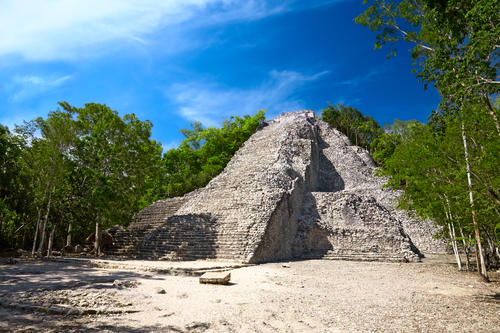 After our group lunch, experience the ancient and mystical Mayan city of Coba. Archaeologists believe Coba is one of the most important ruin sites on the Yucatan Peninsula. The design and purpose of this settlement was very different from other Mayan cities, with various settlements existing in one area. Its largely unexcavated sites covered with vines and trees make it a true wonder of the Yucatan. The sizeable area was once a large city.
After our group lunch, experience the ancient and mystical Mayan city of Coba. Archaeologists believe Coba is one of the most important ruin sites on the Yucatan Peninsula. The design and purpose of this settlement was very different from other Mayan cities, with various settlements existing in one area. Its largely unexcavated sites covered with vines and trees make it a true wonder of the Yucatan. The sizeable area was once a large city.
Here we visit Nohoch Mul, the tallest pyramid in the Yucatan. Nestled deep in the jungle, the structure rises 138 feet from the earth. Be prepared to climb the steep, 120 stone steps that lead to a simply breathtaking panoramic view of the Yucatan and closed off areas of Coba. The view at the top is definitely worth the climb. As a light breeze cools you off at the summit, you will be able to see the Macanxoc Lagoon to the east and Cobá Lagoon to the southwest. The jungle stretches out beneath you in all directions.
As we explore the architecture of the three open settlements, we will be walking in the footsteps of the ancient Maya, following the original sacred sacbe (white roads), shaded by the lush, green canopy overhead.
This evening a special presentation from Gregg.
Day 3 / Monday, January 20 (Breakfast and lunch included)
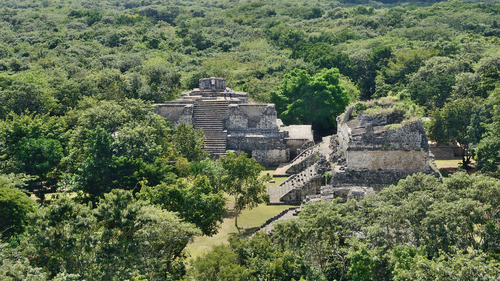 After breakfast at our hotel, depart for the Yucatan’s best kept secret, and much less visited, magnificent ceremonial center of Ek’ Balam. Surrounded by jungle, Ek’ Balam, whose name means “Black Jaguar,” is very impressive with its enormous Acropolis-type pyramid. Restoration has only been going on for a few years and only 1 square kilometer of the 12 square kilometer complex is accessible to the public.
After breakfast at our hotel, depart for the Yucatan’s best kept secret, and much less visited, magnificent ceremonial center of Ek’ Balam. Surrounded by jungle, Ek’ Balam, whose name means “Black Jaguar,” is very impressive with its enormous Acropolis-type pyramid. Restoration has only been going on for a few years and only 1 square kilometer of the 12 square kilometer complex is accessible to the public.
The buildings are enormous, with highly decorated facades. The two concentric walls surrounding the center of this Mayan city and the many smaller walls that snake through the site are what define this ruin. The most important structures are found within the Central and South Plazas. Large, raised platforms line the interior wall and Sacbe roads radiate out from the center in the four cardinal directions.
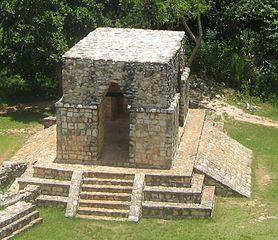 It is the architecture and design of one of the largest Mayan structures in the Yucatan, El Torre, or The Tower, however, that simply amazes archaeologists. The Tower measures over 500ft long, 200ft wide and reaches 100ft high and is home to some of the most intricate stucco design motifs found in the Yucatan. The brilliance of the Maya truly shines through at this site.
It is the architecture and design of one of the largest Mayan structures in the Yucatan, El Torre, or The Tower, however, that simply amazes archaeologists. The Tower measures over 500ft long, 200ft wide and reaches 100ft high and is home to some of the most intricate stucco design motifs found in the Yucatan. The brilliance of the Maya truly shines through at this site.
After a group lunch, we end our day with a visit to Hubiku Cenote, a cavernous freshwater pool in a light-filled limestone cave. A Cenote is a naturally formed sinkhole - many of which are in the Yucatan peninsula. The word Cenote comes from the Mayan word “D'zonot”. Cenotes are considered sacred wells in Mayan culture and were used to make offerings to the Gods. Seminar this evening.
Day 4 / Tuesday, January 21 (Breakfast and lunch included)
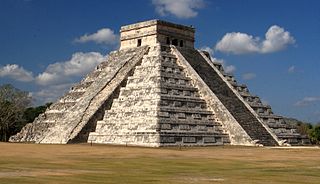 Breakfast at the hotel, then we travel to Chichen Itza, a UNESCO World Heritage Site and one of Mexico’s most visited destinations. Chichen Itza translates to “Mouth of the Well of Itza.” On the city’s Great Northern Platform stands The Temple of Kukulkan, also called El Castillo. This striking step pyramid, which rests on top of a much older temple, dominates its surroundings as the majestic centerpiece of the ancient city. The pyramid has four sides, each with 91 steps, which when capped with the final platform at the top, total 365 and represent the number of days in the year.
Breakfast at the hotel, then we travel to Chichen Itza, a UNESCO World Heritage Site and one of Mexico’s most visited destinations. Chichen Itza translates to “Mouth of the Well of Itza.” On the city’s Great Northern Platform stands The Temple of Kukulkan, also called El Castillo. This striking step pyramid, which rests on top of a much older temple, dominates its surroundings as the majestic centerpiece of the ancient city. The pyramid has four sides, each with 91 steps, which when capped with the final platform at the top, total 365 and represent the number of days in the year.
Occurring only during vernal and autumnal equinoxes, the setting sun showcases the true mathematical, architectural, and astronomical mastery of the Mayans. As the sun moves toward the horizon, it casts shadows on the pyramid, beginning at the top and working toward the bottom, depicting the Descent of Kukulkan, the serpent deity and namesake of the temple, slowly slithering it’s way down the steps to enrich the earth with the sun’s energy and water for farming.
There are other structural wonders, as well, including El Caracol, the Temple of Jaguars, the Temple of Warriors, and the Ball Court, each unique in design and purpose but similarly designed with respect to the heavens.
After a day at this most amazing city, you’ll appreciate why Chichen Itza is listed as one of the “New Seven Wonders of the World.” Lunch included.
Day 5 / Wednesday, January 22 (Breakfast, lunch and dinner included)
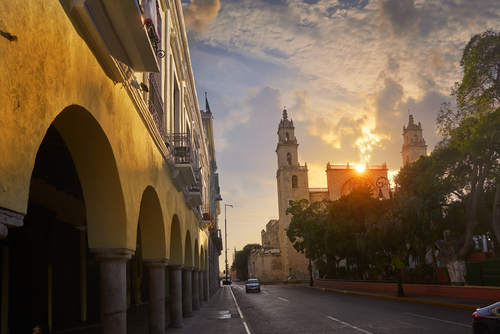
Breakfast at the hotel, then transfer to Merida, the capital of the Yucatan, and check into your hotel. Dinner included. Meeting with Gregg this evening.
Day 6 / Thursday, January 23 (Breakfast, lunch and dinner included)
Breakfast at the hotel, then travel to the famous Mayan complex and ceremonial center of Uxmal, a World Heritage Site and another of Mexico’s most prized and important archaeological destinations. Populated by roughly 20,000 residents at its peak, this expansive city was also well connected to other nearby locations, including Kabah, Labná, and Sayil.
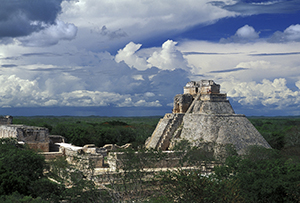 Uxmal means “thrice built” and is named after its tallest and most popular structure, the Pyramid of the Magician, which actually represents five known phases of construction. At 115 feet tall and with rounded corners and an elliptical base, the pyramid is distinct from typical Mayan architecture. Despite its uniqueness, it does still reflect the Mayan focus on astronomy, as the western staircase faces the sun directly during the Summer solstice, and the central doorway aligns with Venus.
Uxmal means “thrice built” and is named after its tallest and most popular structure, the Pyramid of the Magician, which actually represents five known phases of construction. At 115 feet tall and with rounded corners and an elliptical base, the pyramid is distinct from typical Mayan architecture. Despite its uniqueness, it does still reflect the Mayan focus on astronomy, as the western staircase faces the sun directly during the Summer solstice, and the central doorway aligns with Venus.
Uxmal, unlike other famous Mayan sites, was devoid of cenotes, and water was subsequently scarce. It was therefore an important elemental necessity for life and a recurring theme throughout the city, personified by the god of rain, Chac, who is honored repeatedly at the various sites within the complex.
The Governor’s Palace, echoic of the local devotion to Chac, is thought to be among the most recently added buildings, and is recognized as one of the premier examples of Puuc architecture throughout the Mayan Empire.
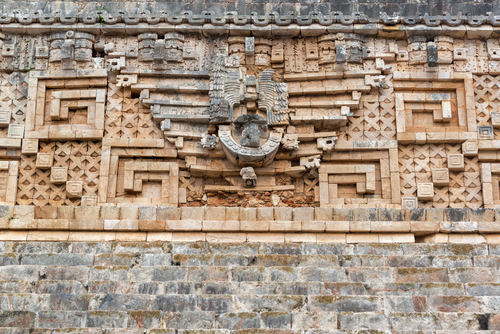 The Puuc style makes repeated use of a series of architectural elements outstanding because of their technical perfection. In contrast with buildings in other Mayan regions, Puuc buildings were made with a solid nucleus of stone and plaster, covered by well-cut, worked stone that is purely ornamental rather than structural.
The Puuc style makes repeated use of a series of architectural elements outstanding because of their technical perfection. In contrast with buildings in other Mayan regions, Puuc buildings were made with a solid nucleus of stone and plaster, covered by well-cut, worked stone that is purely ornamental rather than structural.
Fronted by the Jaguar Throne and consisting of a 320 foot long mosaic façade, it features an array of 103 stone masks surrounding the central divine figure wearing an elaborate headdress. This is not to be missed!
Later named “Casa de las Monjas (The Nunnery)” by the Spanish because of its resemblance to a convent, the Nunnery Quadrangle is also an exemplary Puuc construction. Consisting of four buildings facing an inner courtyard and adorned with intricate facades, serpents, masks and other thematic stylings, the building stands in honor of, and supplication to, Chac, for the bounty of life-sustaining water.
Group lunch on site. Return travel to the hotel. Dinner at hotel.
Day 7 / Friday, January 24 (Breakfast and lunch included)
 Breakfast at the hotel, then transfer to Merida airport for a short flight to Villahermosa, the capital city of the Mexican state of Tabasco, where we visit Parque La Venta Olmec Museum, a lush, open-air museum within the city. The museum is named after La Venta, a coastal site where numerous relics and pieces of Olmec art were discovered. The Olmecs, a people who inhabited North America as long as 10,000 years ago, are thought to be the forebears of Mayan culture. Most famous and most mysterious of the recovered artifacts are the enigmatic Olmec Heads, intricate and sophisticated artistic creations of immense size, weighing 30 tons and more. Amazingly, the Olmecs were able to somehow transport these megalithic stone structures more than 100 miles.
Breakfast at the hotel, then transfer to Merida airport for a short flight to Villahermosa, the capital city of the Mexican state of Tabasco, where we visit Parque La Venta Olmec Museum, a lush, open-air museum within the city. The museum is named after La Venta, a coastal site where numerous relics and pieces of Olmec art were discovered. The Olmecs, a people who inhabited North America as long as 10,000 years ago, are thought to be the forebears of Mayan culture. Most famous and most mysterious of the recovered artifacts are the enigmatic Olmec Heads, intricate and sophisticated artistic creations of immense size, weighing 30 tons and more. Amazingly, the Olmecs were able to somehow transport these megalithic stone structures more than 100 miles.
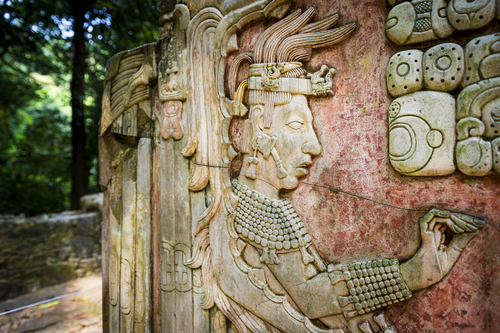 After lunch, travel to Palenque and enjoy a tranquil afternoon at this preeminent Mayan historical site. Another UNESCO World Heritage Site, the city is testament to the marriage of Mayan mythology with their advanced understanding and application of science, architecture, and art.
After lunch, travel to Palenque and enjoy a tranquil afternoon at this preeminent Mayan historical site. Another UNESCO World Heritage Site, the city is testament to the marriage of Mayan mythology with their advanced understanding and application of science, architecture, and art.
Day 8 / Saturday, January 25 (Breakfast, lunch and farewell dinner included)
After breakfast at the hotel, we will return to the ruins at Palenque, widely considered the most impressive and aesthetic of all of Mexico’s Mayan destinations. Nestled atop a high plateau surrounded by thick, lush jungle, Palenque is home to various historical attractions, including temples, plazas, a royal palace, and a ball court, but most important to the complex and our understanding of its history is the Temple of the Inscriptions. Built as a funerary monument to King Pakal the Great, the Temple of the Inscriptions houses tables of Palenque’s dynastic history as compiled by Pakal himself. We then visit the Temple of the Cross, the Temple of the Sun, and the Temple of the Foliated Cross on the Eastern Platform across the Otolum River. Built by Pakal’s son, Chan-Bahlum, like the Temple of the Inscriptions, these three temples are elegantly symbolic structures filled with elaborate carvings of priests, jaguars, and other religious imagery, and they showcase interior chambers that explain rituals and allegiance to Mayan gods.

In addition to the rich local history on display at Palenque is a seeming link to the larger ancient world. Because of striking similarities to other archaeological sites like Angkor Wat in Cambodia and various Buddhist and Hindu temples in India, some experts have suggested a link between these distant peoples and cultures. Lunch on site is included.
Tonight we will share a special farewell celebration dinner!
Day 9 / Sunday, January 26 (Breakfast included)
Breakfast at hotel, then transfer back to Villahermosa for your flight to Cancun, where our journey through Mayan culture concludes.